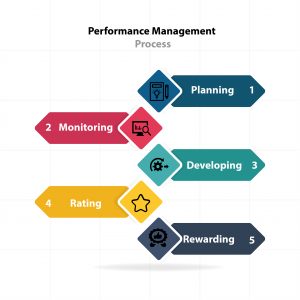
Organizational success is largely dependent on their employee’s performance. A committed employee is more like a sound investment for a company that is only going to give better returns in the future.
So, the big question is how do you rate employees? How can managers and HR professionals strategically outline the performance of their employees, without being misguided or hated for the same? This is where the role of an important business tool, Employee Performance Management comes in.
Performance Management does not simply imply a measure of an employee’s existing performance. It has a deeper and significant meaning and this post explicates the same.
Performance management is a set of processes that identifies measures and help to improvise an employee’s performance to meet organizational goals. It helps to improve the employee-management relationship and building a high-performance workplace.
Read on to get a complete overview of the Performance Management feature and implement it successfully in your business.

Meaning of Performance Management
Performance management is a systematic process that supervises and monitors the role of individual employees or departments to ensure that they meet and achieve the organizational objectives in an effective and efficient manner.
It is a tool to make employees more productive and motivated to improve their skills and competencies. It is an ongoing process that begins with the job in hand and ends only after the employee leaves the organization. Performance management can be applied to individual employees or a team collectively.
In the current working scenario, competition in business is tough and grueling. While globalization has contributed to increased business opportunities, it also has led to an increase in complexities of monitoring the performance of the workforce, brought together from varied cultural norms.
This has compelled companies to hire HR professionals who help organizations to recruit employees, monitor their progress and also retain the best ones. The role of HR is evolving and centers on active employee engagement and participation. Mr. Bob Nelson, a leading advocate for employee recognition stated that “As the world of business has become more high-tech, virtual, and moving with constant change, management needs to be more personal in how it deals with workers“.
In order to simplify the job of HR professionals, the performance management system or process comes into play. It is rapidly gaining momentum owing to its integrated and strategic approach.
Performance management is a tool that helps the employees to remain motivated and progress in a manner to stay aligned with the organization’s mission. Therefore the two main elements that define performance management are
- It’s a continuous process
- It’s linked to the company’s mission and goals

HR professionals use performance management to measure the current competency of employees and use the assessment to improve their work efficiency over time.
If implemented correctly, it can bring a drastic positive change in the company, at all levels. Performance management has aptly replaced the traditional performance evaluation method used by the managers earlier to access the work efficiency of the employees.
The History Of Performance Management
As discussed earlier performance management is a systematic process designed to recognize ways to fulfill a company’s preset goals through ongoing assessment of employee’s performance. Unlike the annual evaluation or performance appraisal process, performance management is a continuous process to build a stronger and competitive workforce.
The success of a performance management system is quite apparent and businesses now have figured out the same. yet, this is not a new concept. According to various sources, the earliest use of performance management dated back to the era of World War I when WD Scott first implemented the concept of performance appraisal.
However, WD Scott’s system did not gain much momentum then and it was only during mid- 1950s that business started implementing it. The companies then began using personality-based systems to access employee performance. By the end of the decade, this system started showing adverse results as it lacked self-appraisal.
There is a need for a more comprehensive approach to performance assessment and it was in the 1960s that organizations started focussing more on self-appraisal systems. During this time, the performance appraisal systems monitored the performance of employees to achieve the company’s goals and also helped them to excel in the future. Undoubtedly, the results were dynamic and in the next two decades, organizations began adopting a more holistic approach to employee performance appraisals and management.
The appraisal process incorporated new psychometrics in their system like teamwork, communication, self-awareness, controlling emotions and conflict reduction at a workplace. The appraisal process was no longer secretive and became more open and participative, besides being development driven.

In the last two decades, performance management has evolved further by creating a more engaging and friendly working environment. The approach is more methodical and emphasizes primarily on development, planning, and improvement. This led to initiating the brand new 360-degree feedback that enabled managers to gather feedback on employee’s performance from multiple sources.
“The annual review process no longer holds as the only yardstick of performance evaluation. It is imperative that the annual review is augmented with real-time feedback.”
– Saswati Sinha, VP and Head HR, Cheil India

The employee performance management system is still progressive and dynamic. In the coming future, you can only expect it to become more transparent and objective.
Evolution Of Performance Management
The traditional performance management practices used earlier were unyielding. According to the statistics of the Deloitte survey conducted in 2015, nearly 58% of HR professionals described their employee performance management practices to be ineffective and unproductive.
 An ineffective performance management system does not only result in a waste of time and resources, but it also lowers productivity. It also dampers the morale of employees and leads to reduced engagement and a higher rate in attrition.
An ineffective performance management system does not only result in a waste of time and resources, but it also lowers productivity. It also dampers the morale of employees and leads to reduced engagement and a higher rate in attrition.
Kaustubh Sonalkar, the CEO of the Essar Foundation stated that “Organisations will have to move away from ratings, instead of design performance management strategies and align with overall business goals.”
Companies were in dire need of an effective, comprehensive performance management process that proved beneficial for employees, managers, and organizational development. The performance management process thus evolved in these five phases –
First Phase
After WD Scott’s documented system failed to make an impact, companies started using the performance appraisal process in the early ’60s. Appraisals were then based on the ‘Annual Confidential Reports (ACR’s)’ also known as ‘Employee Service Records’ Employee Service Records’. The content in these reports provided information about employee’s performance and maintained with strict confidentiality.
The ACR’s in a way presented vital information about employees and the assessments were done usually on a ten-point rating basis. Some of the traits that were judged in this process were punctuality, job knowledge, sincerity, loyalty, dynamism, and leadership to name a few. Judgments on these traits were passed in a secretive manner and never communicated to the employees.

It was a closed-end process and the employees had no form of participation in any stage of assessment. However, any negative remark in these reports adversely affected the career growth of the concerned employee. This system lacked transparency and therefore suffered major drawbacks.
“Transparency and openness is the key to any effective performance management system.”
– Vinod Bidwaik, CHRO & Vice President HR at Alfa Laval India
Government organizations in those days implemented this approach.
Second Phase
The second phase of performance management started in the late 1960s and continued till the early 1970s. The key attribute that defined this phase was that any negative remarks documented in the reports were communicated to the employees. The employees could then undertake corrective measures for the same and implement ways to improve work efficiency in the future.
“It is important to occasionally show employees where they need to improve as people generally respond more strongly to negative events than positive ones, it is vital for managers to learn how and when to give negative feedback.”
– Rajesh Padmanabhan, Director, and Group CHRO at Welspun Group

The performance appraisal process in the second phase imparted discretionary powers to the reviewing officer and could even revoke the reporting officer’s ratings. Employees received a formal written communication on the traits that were marked below 33%. This communication was then used to identify areas of improvement and work on it in a progressive manner.
Third Phase
During the third phase of evolution, the ‘Annual Confidential Reports’ were completely replaced by performance appraisal. The key hallmark change in this stage enabled employees to present their accomplishments in the performance reports. These accomplishments were described in the form of self-appraisal and done on a yearly basis.

Other than the traits used in the earlier phases of assessment, various new components were introduced that measured the performance and productivity of employees in perceptible terms like individual competencies, targets achieved, etc. Few companies began introducing training needs in their performance appraisal forms. Yet here too the reports were still maintained confidentially and the system was still far from being development-oriented.
Fourth Phase
The beginning of the fourth phase kicked off from the mid-1970s and during this time performance appraisals became more development driven and performance-based. The confidentiality aspect of the reports was withdrawn and the entire process became more participative and open-ended.
The fourth evolutionary phase of performance management was initiated in India when business barons like Larsen & Toubro and public sector banking companies like State Bank of India introduced progressive reforms in this field.
With time, appraisal processes that were formerly based on personality traits slowly evolved to based on objectives and goals. Corrective action plans were also introduced to help employees to accomplish better in the future.

The review process was transparent and the reporting officer and concerned employee mutually agreed on the crucial areas to be accessed, at the start of the year. The review process was done every six months. During the review period besides discussing the ratings, other aspects such as factors affecting performance, newer targets and their training needs were also talked about with the employee in a coactive way.
“The performance management strategy is better developed in collaboration with all stakeholders which include employees, managers, directors, and consultants, led by the HR team.”
– Mahmoud Mansi, Human Capital Consultant, Protiviti
It was during this phase that organizations began hiring HR professionals exclusively to deal with various issues of employee performance management.
Fifth Phase
The structure of performance management underwent a drastic and positive transformation in this phase. The entire process became more and more development driven and building a productive work culture at all the levels of the organizational hierarchy.
During this phase, newer traits like team appraisals, communication, culture building, and conflict reduction were given utmost importance. 360-degree feedback became the newest tool to get employee ratings from multiple sources.

“The essence of Performance Management is that it is a feedback loop that allows people to assess if they are doing the right things and working well within the culture of the company.”
– Ravi Bhogaraju, Global Head Talent & Development, Archroma
Towards the beginning of 2000, organizations started adopting annual performance reviews as the most effective means to access employee performance. The performance management system is still evolving.
Josh Bersin, an established industry analyst predicted the transformation of HR operations with the incorporation of HR Artificial Intelligence (AI). The prominence of performance reviews will shift to quality from quantity over time.
Objectives of Performance Management
Performance management is a tool to improve individual and business performance on a whole. It helps senior managers to not only discern ‘What is to be achieved?’ but also ‘How it should be achieved?’ Employee performance management helps to achieve desired results by accessing performance through a mutually agreed framework of defined goals, objectives and competencies.
Even though the performance management process is beneficial to the employees and supervisors both, lack of communication sometimes renders the process ineffective. This communication gap is the main hindrance to why employees fail to fulfill the job as expected.
“Periodic sessions of feedback and interactions are making things more lucid and meaningful both the organizations and the individuals, creating room for midstream corrections and developments.”
– Tarun Midde, HR Consultant, Partner In Progress
An effective performance management system should overcome these challenges. It is expected to improve employees’ competence to meet strategic business objectives. Employees must be enabled to do self-appraisal with complete guidance and support from managers and team leaders.
The key objectives outlined for an effective performance management system are –
- Align employee’s objectives with those of the business.
- Bridge communication gap by fostering talks, discussions, and reviews between employees and supervisors.
- Enable leaders to channelize organizational energy to meet business objectives. It also includes setting a sound selection process in accordance with the company’s policies so that only the right candidates are hired for the job.
- Promoting self-appraisal in employees to enable them to improve their knowledge and skills to perform the given task in an effective manner.
- Present adequate resources for personal development. Presenting employee’s unbiased feedback continually during their performance delivery period.
- Identify the obstacles to effective performance and improvise ways to overcome them by constant monitoring and training sessions. Facilitating complete career development support for employees on a regular basis.
- Improve organizational performance by assessing current employee performance and also presenting plans for improvement.
- The key focus of the performance management system should be based on development and improvement. It should create a positive work culture through constant reviews, feedback, and open-ended conversation.
- Implementing a defined a rewarding system for employees who fulfill respective performance benchmarks.
- Holding exit interviews to decipher the reason behind employee’s discontentment and the cause for leaving the job.
- Performance management should strive a balance between ‘what is achieved’, ‘why it was achieved’ and ‘how could it get better’. It is a two-way process that deals with the effectiveness and competence of both employees and the business.
“For managers to really raise performance requires a shift in mindset requiring them to view their roles as enablers to allow their staff to be the best version of themselves in the workplace.”
– Shakil Butt, Independent HR Consultant
Key Concerns Of A Performance Management System
The complexities in the work culture coupled with rapidly changing organizational structure have hindered the efficient use of the performance management system. Experts also feel that performance is a complex phenomenon and therefore cannot be measured accurately.
“The key for organizations is to equip managers with the skills and the abilities to develop and grow their staff, and view performance management as integral to the role of the manager and the business, not just a tick-box exercise or a ‘nice to have’ fad.”
– Kessar Kalim, Director of HR at London School of Hygiene & Tropical Medicine
To date no performance management system has been devised that is precise and error-free. However, measures have been taken to implement them in the best possible way at tactical, strategic and operational levels of businesses. Here are the key concerns of any performance management system:
- A performance management system should not solely focus on the achievement of the desired performance. Instead, it should also concern the competence, skill of employee and the required training/coaching sessions to achieve desired outcomes.
- Expectations are to be defined ahead and mutually agreed upon by the employee and the supervisor, through accountabilities and role responsibilities.
- Aligning employee’s objectives with those of business and creating an environment where employees feel motivated to work and strive to reach higher standards. Establishing clarity about an individual, team and organizational effectiveness and ensuring adequate measures are being taken to achieve them.
- The performance development process should be viewed as a continuous process that fosters a learning environment to fulfill set targets.
- Being an open-ended system that shall make employees more committed and engaged.
- Ensuring friendly and engaging dialogue between employees, supervisors and team members. Establish a mutual understanding to work in harmony to achieve organizations’ mission and objectives.
- The performance management system is also concerned with fulfilling the expectations of the company’s stakeholders, suppliers, customers and even the general public besides those of employees and managers. Employees, in particular, are encouraged to defend the organization’s core values and work with the belief that achieving business objectives shall be beneficial to them.
“If we can build a culture within our organizations that support consistent transparency, and change the mindset that pointing out something that isn’t working is a good thing and beneficial to the business instead of a personal attack on one individual, our employees will have mutual trust, enhanced engagements, and our businesses will thrive.”
– Jennifer Currence, President, OnCore Management Solutions LLC
The four crucial pointers that reflect the successful implementation of a performance management system are-
- Respect for employee
- Mutual understanding
- Procedural integrity
- Transparency in decision making
Components Of Performance Management System
Performance management is an integrated system that presents myriad benefits to the employees, team members, and leaders. It is implemented not only to measure employee performance but also boost employee satisfaction & engagement and foster a harmonious work culture through continuous feedback to facilitate goal setting. Given below are five vital components of a successful employee performance management process.
#1 Understanding the expectations
The first crucial element for successful implementation of a performance management system is being clear about job expectations. Managers and supervisors must clearly communicate with employees what is expected from them, in a way that is clearly understood. The focus is entirely on targets, role requirement and performance measures.

“Performance expectations should be set forth from the onset, whether via a statement of work or the rules of the engagement.”
– Jeanne Achille, Founder, and CEO, The Devon Group
#2 Performance planning
It is extremely important that the reviewing officer and appraiser mutually agree on the performance objectives at the beginning of the work session. Managers are not just accountable for setting performance expectations; they should also be actively engaged in providing feedback and recognizing excellent work. Active participation of management is imperative to the success of a performance management system.

“The performance management strategy is better developed in collaboration with all stakeholders which include employees, managers, directors, and consultants, led by the HR team.”
– Mahmoud Mansi, Human Capital Consultant, Protiviti
#3 Feedback and Coaching
Constant feedback and coaching ensure that the company’s objectives are fulfilled and help employees to improve their performance. T N Hari aptly quoted that “The inability to give timely, accurate, and specific feedback as a result of which many decisions turn out to be surprised and leave a bad taste in the mouth”.

“Regular check-ins allow managers to coach in a timely manner and subordinates to reflect and apply their learning more effectively.”
– Dr. Linda Holbeche, Co-Director, The Holbeche Partnership
It functions as a transparent process where the employee and appraiser mutually discuss the performance achievement, areas of improvement and corrective measures needed for the same.
#4 Rewarding Good Performance
How do you keep your team encouraged to work? How do you establish a friendly and engaging work culture? What are the ways to ensure that employees look forward to new work?
Rewards and recognition exactly do that you. Most of the time, managers feel that incorporating rewards can add extra expenses to their business model. But, they don’t.

“Recognize and reward your staff along the way and throughout the year to help keep them motivated, engaged and retained.”
– Tana M. Session, Speaker | Coach | Trainer | Consultant
Recognizing an employee for their remarkable performance boosts their self-esteem and propels them to perform better. Extravagant rewards are not needed and a simple thank you note or recognizing employee’s performance amidst staff meetings are simple rewards that are extremely valued.
#5 Performance improvement plans
This component brings together the other discussed elements of any performance management system. Organizations should build a work culture that is laid on the foundation of unbiased work discussions, positive feedback, mentoring and development plans.
When employees miss deadlines to fulfill objectives, supervisors openly discuss the areas of improvement and the required training and improvement plans. A new stipulated deadline is also set jointly by the appraiser and appraise.

“Frequent and meaningful feedback from supervisors immediately after client engagements becomes more important for developing people than relying simply on annual performance reviews to review development needs.”
– Dr. Linda Holbeche, Co-Director, The Holbeche Partnership
The performance management system is a rapidly adaptable process that needs to remodeled periodically. It should focus on the higher levels of goal attainment rather than measuring against the minimum. The system should be a mirror to a positive future and should not dwell in the past.
Why Is Performance Management Important?
One of the most misleading concepts creeping into the present work culture scenario is that appraisals can improve workplace performance. Well, it doesn’t’. So how can organizations improve workplace productivity? What can be done to improve employee engagement? What can be done to retain top talent and help them to be more productive?
A performance management system is the most powerful tool that fulfills the above-mentioned aspirations. Appraisals are effective only when they function as a part of the performance management process. Companies like Google are ditching the traditional annual appraisals and making the smart switch to the contemporary performance management system.
A performance management system is implemented to efficiently manage employees by promoting employee engagement and retention. It helps to align an employee’s objectives with organizational goals. If you are still figuring out the need for performance management in your organizations, these pointers below outline the importance for the same.
Reward and Recognition
It is a proven fact that happy people tend to work better. Employees are more motivated to work when their talent is recognized, appreciated and even rewarded. A recent survey confirmed that 69% of employees work harder when they feel valued and reward.
Reward and recognition should only be based on accurate and transparent performance feedback. This is where you need the assistance of a performance management system. It helps to identify and recognize the exceptional work of employees at all levels and implement an effective reward structure.
Set Goals
The foremost determinant of implementing an effective performance management system is goal setting. When you set goals and even associate awards with the same, employees are motivated to work towards them and perform well.
“Those organizations where Performance Management discussion is continuous with goals linked to performance and development, and prioritizing talent skills and mobility linked to business needs, have the greatest positive impact on business success, in terms of revenue, as well as retention and employee engagement.”
– Kevin Lyons, Senior HR Manager, Pearson
Improves Employee Engagement and Productivity
Employee engagement is important as it helps to boost productivity and encourages them to deliver at their highest potential. A performance management system is a vital tool to keep employees engaged. A company that shows genuine interest in their employees and builds an atmosphere of trust and support is more likely to meet their targets. Statistics have shown that boosting employee productivity has helped companies to witness a hike in their revenue every year.
Fosters Transparency at Workplace
It is an undeniable truth that even now 50% of employees are still not clear of their role and contribution to organizational success. This is one of the reasons why performance management is important as it encourages communication between employees and team leaders. It provides employees with a clear understanding of their job and the level of performance expected. The employee management system eliminates any confusion and ambiguity at all levels of the management hierarchy.
“The strongest leaders will always be people developers, good listeners, and role models who demonstrate ethics, transparency, and trust.”
– Paul Falcone, Bestselling Harper Collins / AMACOM Books author
Initiate Development Strategies
A sound performance management system helps to proactively develop employee skills. It functions as a continuous process that recognizes the strengths and weaknesses of employees while offering full support and training in the areas of development. A performance management system helps to create an environment that propels employees to excel and move forward in a direction to realize a company’s goals and objectives.
A performance management system can only give desired results if it is implemented in a proper way. Here are some prerequisites of a good performance management system that should adhere to.
- Performance management processes should be participative and encourage the involvement of all employees in an organization.
- The top leaders and managers must be cooperative and supportive to encourage a positive workplace culture.
- The company’s goals and objectives should be clearly outlined and communicated to employees at all levels of the organizational hierarchy. The efforts should thereby be directed to achieve the same in the best possible way.
- The leadership team should clearly state the performance target, the desired result and the timeframe allotted to achieve the same.
- Targets should not be set individually. Rather top leaders should develop a performance strategy that persuades employees to work together, collaborate and achieve exceptional results.
- Effective and open-ended communication is extremely crucial. It makes the employees feel valued and motivates them to deliver the best performance. Communication is vital as it defines the job at hand and the expected results.
- Recognizing and rewarding talent is beneficial for any organization. It should, therefore, be incorporated within the performance management framework.
Soumyasanto Sen who is an advisor in People Technologies also quoted that “Performance management, when handled skillfully in an organization today, can increase job satisfaction, employee retention, loyalty, and overall performance of the organization.”
Successful implementation of the performance management system helps the HR leader to elevate individual and team productivity in the following ways:
- Calibrate day-to-day tasks of employees with predefined objectives of the company
- Demanding answerability around performance expectations and ways to improve in the future.
- Tracking individual employee performance to aid in career planning decisions.
Performance Management Process
A performance management process is a continuous process that fosters employee communication. Its key goal is employee engagement and organizational improvement. When a performance management system is implemented effectively it helps in making your employees more productive and profitable. The systematic processes that define a good performance management tool are –

Planning
The planning stage allows supervisors to create a performance plan and set measurable goals. However, they must openly consult and discuss with employees. Team leaders should clearly define employee expectations and also explain how their performance is linked to the company’s objectives.
“Performance management by philosophy needs to be more developed for employee development and to monitor and track performance and development and not really a tool to decide employee salary revision.”
– Ajay Ambewadikar, Country HR Manager, CNH Industrial
Monitoring
Unlike annual appraisals that are done once every year, in a performance management process supervisors need to review and access their employee’s performance on a continuous basis. Monitoring helps team leaders to suggest corrective measures and adjust timelines, wherever needed. This stage also enables supervisors to communicate with the employees their current performance measured accurately in accordance with the company’s goals.
“Having a right and continuous performance management system helps an organization to convert, monitor, provide feedback and course correct, strategize the long-term objectives and its execution.”
– Srinivas Chunduru, Founder and CEO, VANS
Developing
After the monitoring process, team leaders need to access if the employees need any development program to help them achieve assigned targets. This employee development process should not only focus on remediation but should even impart assistance to excel in their performance.
“Performance Management should be able to identify talent, enable development and inculcate ownership.”
– Colin Mendes, General Manager & Head of Human Resources at Voltas Limited
Rating
The insight gained during the monitoring process should help team leaders to assign a genuine and transparent rating record of the employees, based on their progress. The rating should however not come as a surprise for the employee as all the aspects were discussed openly.
“A culture fostering trust, openness, and transparency along with the simplicity of executing the desired practices holds the key.”
– Rajesh Padmanabhan, Director, and Group CHRO at Welspun Group
Rewarding
Last but not least, rewarding is an integral process of any performance management system. It should be personal, public and timely. Team leaders should genuinely award distinctive performances of individual employees.
Rewards for employee’s accomplishments can be in the form of bonuses, promotions, verbal conversation or even a written thank-you note.
Managers can create a robust performance management process by actively engaging with employees, generating feedback and providing development opportunities. It fosters employee’s participation in the company’s growth.
Conclusion
The absolute objective of a performance management system is not to make employees happy. It should instead motivate them and help to unlock their potential. An effective performance management system motivates both employees and managers to strive for excellence.
In recent years, the pace of workspace is rapidly changing and many companies worldwide, are pulling down the traditional hierarchy in favor of the performance management system. The manner in which companies adapt to the performance management system may differ, but it is definitely the time to make the switch to new approaches to performance management.
It is not only a fundamental aspect of the employee value proposition but also alleviates the administrative burdens of an organization. Employee performance management has become an indispensable tool in the corporate world. Management processes ensure that the employees uphold the company’s values and move towards the accomplishment of the ultimate corporate mission.
Employee performance management is making big changes in organizations that go beyond HR processes. It touches everybody!
#Employee Engagement #employee performance management #employee performance management process #Performance Management #performance management process #performance management system
[…] the process of providing feedback to employees can be a daunting task. The most successful performance management systems provide a framework to give and receive feedback on a continuous basis and not just during […]
[…] the process of providing feedback to employees can be a daunting task. The most successful performance management systems provide a framework to give and receive feedback on a continuous basis and not just during […]
Great article. While browsing the web I got stumbled through the blog and found more attractive. I am content with the content as I got all the stuff I was looking for. The way you have covered the stuff is great. Keep up doing a great job.
[…] engagement and performance management are intertwined – two sides of the same […]
[…] discussing the effectiveness of the Performance Management System, the first thing that comes to our mind is performance reviews or the annual […]
[…] only that encourage employee participation linking the performance management with retention, development and succession planning initiatives can help to put a stop to this […]
[…] are all trying to do less with more and because of that, there is a huge focus on productivity and performance management. It goes without saying that the best way for your business to perform better is to improve your […]
[…] driver for a company which helps in maximizing the present strategic pathways. In simple words, the performance management system is a process with the help of which you will be able to determine, measure and develop the […]
[…] A company cannot function without adopting effective communication methods. This is particularly true in the performance management process. […]
[…] corporate world evolving at a fast pace, review systems need to catch up as well. It is here that performance management systems are of great assistance. Performance management software helps in reviewing performances on […]
[…] bring an ongoing cadence to performance management, instead of episodic, once or twice a year, occurrences. OKRs provide employees and managers a […]
[…] the onboarding process is smooth and fully integrative. A good leader knows when to step in for performance management if there are issues and how to manage someone who is performing […]
[…] Performance management is a process by which employees and their supervisor set professional goals to be completed in a set period of time. Goals are usually a mix of things that directly relate to the employee’s job and things that relate to the organization or the industry more broadly. […]
[…] Performance management is an important topic and one that is discussed regularly by business regulators and managers alike. Within every business, if you are expected to succeed and achieve in a particular manner, there will be targets and objectives that have been set for you to achieve. These targets can be set individually or else as a team target – smaller stepping stones building up to a larger organization based goal. […]